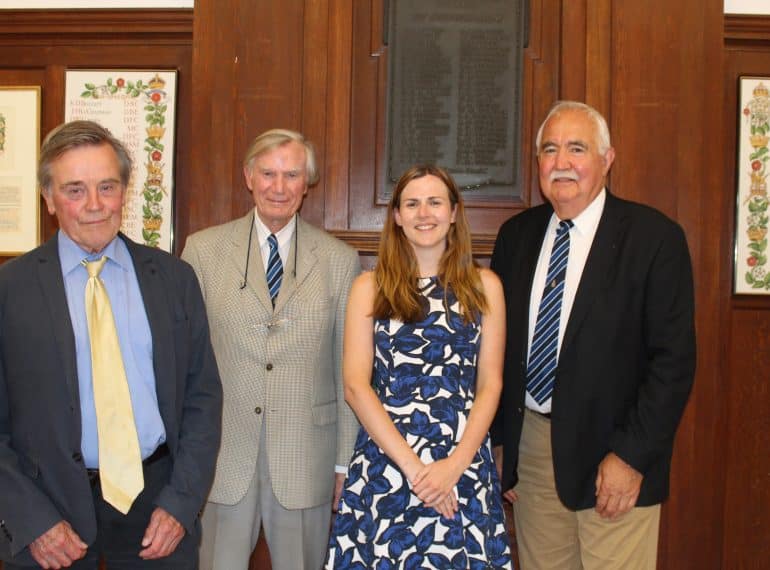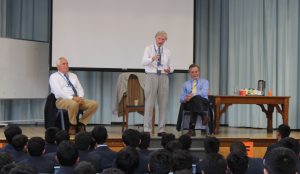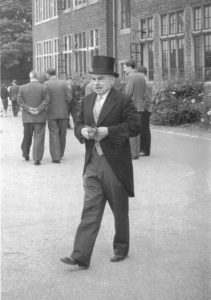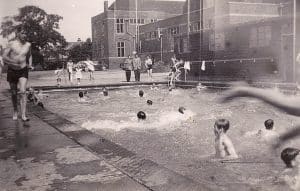Old Elizabethans and Queen Elizabeth’s School: a Summer Term round-up

Three old boys who were at the School in the 1940s, 1950s and early 1960s gave today’s youngest pupils an insight into just how much has changed at QE when they visited to help with a history project.
The Year 7 History students also learned about the life of a School Captain from half a century before that when Mary Smith dropped in to relate the story of her great-uncle, Jack Field, who died in the final weeks of World War I.
And a much more recent generation of Old Elizabethans gave the current First XI a close run for their money in the annual Founder’s Day fixture.
 Ken Cooper (OE 1942–1950), David Farrer (1954–1961) and John Todd (1958–1964), pictured, were introduced by Head of History Helen MacGregor. They reminded the Year 7 boys working on a project about the history of the School that QE had been much smaller in the 1940s and 1950s, with a roll of only about 400-450 boys, split into four Houses, not the current six.
Ken Cooper (OE 1942–1950), David Farrer (1954–1961) and John Todd (1958–1964), pictured, were introduced by Head of History Helen MacGregor. They reminded the Year 7 boys working on a project about the history of the School that QE had been much smaller in the 1940s and 1950s, with a roll of only about 400-450 boys, split into four Houses, not the current six.
During the long headmastership of Ernest Jenkins, which lasted from 1930–1961, discipline was strict. In fact, they recalled, a prefect punished a boy for buying an ice-cream without wearing his School cap…on a Sunday afternoon! The hapless young ice-cream buyer was ordered to write lines when he was caught making his purchase from a shop near his home in Southgate. Although the  older pupil was within his rights – prefects of the time were authorised to dole out such punishments and boys were supposed to wear their caps even when not at school – the visiting alumni recalled that he was considered by his classmates to have gone too far, even by the strict standards of the day.
older pupil was within his rights – prefects of the time were authorised to dole out such punishments and boys were supposed to wear their caps even when not at school – the visiting alumni recalled that he was considered by his classmates to have gone too far, even by the strict standards of the day.
They said that all indoor activities at that time took place in QE’s Main Building, with the hall even being used for lunch for a time after the refectory was bombed by the Luftwaffe in 1941. The lunches themselves were reported to have been dreadful. “The potatoes were black; the meat looked like it had come off the bottom of someone’s shoe,” said Mr Cooper.
At first, all that lay behind the Main Building was the ‘Gun Field’. Later, an unheated, open-air swimming pool was built; boys were expected to swim in it in all weathers.
The whole School met each morning for assembly, addressed by the Headmaster in his gown: all masters wore gowns daily, while prefects wore half-length undergraduate-type gowns.
School ran six days a week, with games on Wednesday and Saturday afternoons. Sport was a huge  part of School life and was very popular: the best memories of many Old Elizabethans from that era are from sports on Stapylton Field, the visitors stated. The rugby and cricket were both good, and QE established a very strong reputation in athletics. Fixtures against the top public schools had been established by Mr Jenkins (pictured above), who modelled the School on such institutions during his long headmastership, which extended from 1930–1961.
part of School life and was very popular: the best memories of many Old Elizabethans from that era are from sports on Stapylton Field, the visitors stated. The rugby and cricket were both good, and QE established a very strong reputation in athletics. Fixtures against the top public schools had been established by Mr Jenkins (pictured above), who modelled the School on such institutions during his long headmastership, which extended from 1930–1961.
Private John ‘Jack’ Albert Field, of Bosworth Road, New Barnet, was just 19 when he was killed by a shell on 29th September 1918. He was serving with the 9th Company, Machine Gun Corps (Infantry). In 1916, he was School Captain and had headed the QE cricket First XI averages, as well as passing the London Matriculation school-leaving examination.
Jack’s name is listed on the Tyne Cot Memorial in Belgium, which was among sites visited by Year
9 historians recently. Sited in the area of the Battle of Passchendaele, it lists 35,000 men with no known grave.
When she came in to speak to the boys. his great-niece, Mary Smith, brought with her letters, including one Jack sent to his sister, Doris; and another written by Jack’s father to Doris’s husband, Bert, asking him to tell her of Jack’s death.
Jack’s letter, dated four days before he died, says his unit was “gradually getting nearer one of the worst places of the line”. He mentions the notorious mud – “the only thing to see and about 1ft deep in places” – and perils from above: “Jerry [the Germans] occasionally drops bombs from aeroplanes in the vicinity but as yet none have fallen anywhere near us.” Portentously, Jack’s own letter concludes: “I had better finish as it is nearly dark.”
His father’s letter, on 14th October 1918, says: “We have just received the sad news that poor Jack has been killed. The officer wrote that he was killed instantaneous [sic] and was buried with two other comrades killed by the same shell.” Written with the emotional restraint characteristic of the era, the letter ends simply: “It is a very great blow to us.
 The OEs chose to bat first in the annual Stanley Busby Memorial Cricket Match, which is played on the Third Field at the rear of the School between a team of past pupils and the current School XI.
The OEs chose to bat first in the annual Stanley Busby Memorial Cricket Match, which is played on the Third Field at the rear of the School between a team of past pupils and the current School XI.
The alumni got off to a brisk start, with positive hitting from both Jayaram Raghuveer (OE 2007–2014), who scored 25, and Omar Mohamed (29). However, wickets fell at regular intervals, leaving the old boys, who were led by Harry Riley (OE 2009–2016), with a total of 138 all out in 19.3 overs.
In reply, the QE First XI went about the chase in aggressive fashion and Rahul Patel’s 46 not out saw them through to victory within 14 overs for the loss of 4 wickets.
QE’s Director of Sport, Jonathan Hart, said: “It was a close game and a good afternoon. The old boys’ team consisted of many past 1st XI players, so it was a good test for our boys.”
